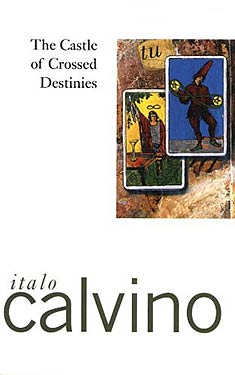Italo Calvino
Completed 2/7/2016, Reviewed 2/8/2016
3 stars
This was a complex, experimental novel about a group of
people gathered at a castle, and later a tavern, telling their recent
adventures not by speaking, but by using cards from a tarot deck. The author uses the images and the patterns
in which the cards are selected to produce probable narratives and gain insight
into the lives and choices of the story tellers. It is not a light read. It is more like a collection of interrelated
short stories dealing with archetypal themes and images.
 The book is divided into two sections, the Castle and the
Tavern. At each location, the
storytellers use a different tarot deck with different images which creates a
variety of details and direction for the story telling, which adds a diversity
to the stories. The images for the cards
are in the outer margin, so you can see the details besides just having the
explanation. This greatly helps the
movement of the stories.
The book is divided into two sections, the Castle and the
Tavern. At each location, the
storytellers use a different tarot deck with different images which creates a
variety of details and direction for the story telling, which adds a diversity
to the stories. The images for the cards
are in the outer margin, so you can see the details besides just having the
explanation. This greatly helps the
movement of the stories.
I got the impression that this was maybe supposed to be a
little like “Canterbury Tales”. However,
I found that the stories quickly ran together.
Even though the stories are different, eventually the same cards are
used, signifying similar situations. It
makes me wonder if this book is not meant to be read in one or two sittings, as
I did, but rather, each story needs to be read and digested individually with sufficient
time between the readings. Perhaps a lot
like the tarot itself. It’s not
particularly helpful to do reading after reading, but rather, to wait and see
what insights came forth.
What really stands out is the prose. It’s well-written and begs the question of
how this book reads in its original Italian.
This is a common question for me and many readers when confronted with a
translation. What is the experience like
for the Italian reader, and how much am I losing in translation. Or, if I was a native Italian speaker, would
I also find the stories run together despite how beautifully written it is. For me this is one of those times when the
prose is not enough to carry a confusing jumble of narratives and by about
halfway through the book, I just wanted to be done with it.
The most interesting part of the book is the Note at the
end. Calvino discusses his process of
putting the book together through the use of actual tarot cards. This and the prose save the book from a two
star rating. I give it three stars out
of five. I’ve been told that Calvino’s
books are very different from each other, so I definitely need to read
something else if I’m to get a different and perhaps more complete perspective
on his literature.
No comments:
Post a Comment